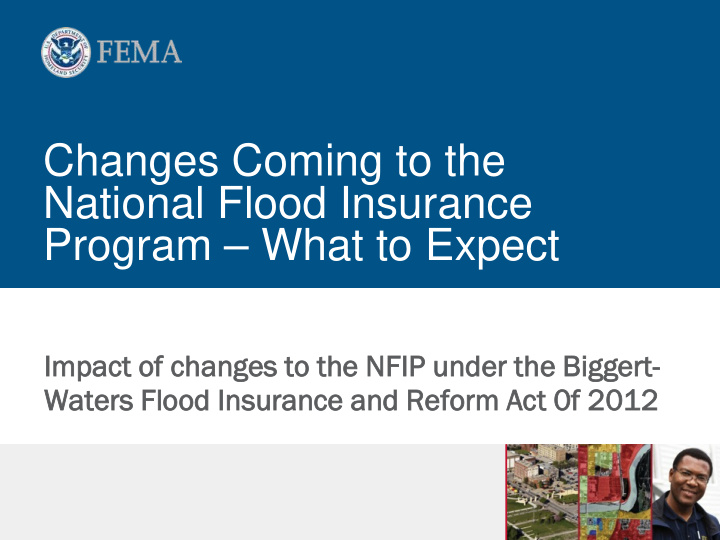



Changes Coming to the National Flood Insurance Program – What to Expect Impact of of cha hanges to to the the N NFI FIP u under the the Bi Biggert- Wate ters Fl Floo ood Insurance a and Refo form Ac Act t 0f f 2012
Why the Changes to the NFIP? 1968: Congr gres ess creat ated the N NFIP to mak ake afforda dable e flood i d insurance generally ly av avail ailable. To par artic icip ipate, communities ad adopt an and enforce flo loodplai ain man anag agement mea measures for all new ew develo lopment. For structures built before FEMA MA map apped the Specia ial Flo lood Haz Hazar ard Area a (called ed pre-FIRM M properties), the NFIP mad ade f flood in insurance av avai ailable at at subsidi dized r d rates es . . 45 y yea ears later er: Th The e costs and d consequences o of f flooding a are e increasing. Artific icia ially l low r rat ates an and d dis iscounts n no l longer ar are s sustainab able. In 2012, Congr gres ess passed l ed legislation to make e the e program m more sustain inable an and financia ially s sound over t the long term. 2
Changes to NFIP Insurance Congr gres ess passed ed the e Bigger gert W Water ers Flood d Insurance e Reform m and d Modernizatio ion Act of 2012 (B (BW-12), ), which h wil ill l in in par art:: Make the NFIP more financially stable by raising rates on certain classes of • property to reflect true flood risk Establish a Reserve Fund (5% for most policies) • Annual premium adjustment cap raised from 10% to 20% • The e chan anges will ill mean rat ate increa eases es f for most policyholde ders Implementation BW-12 Section 100205 Partial Implementation Jan & Oct 2013 • BW-12 Section 100204 Over 5 residential coverage limit – June 2014 • BW-12 Section 100210 Deductible changes - June 2014 • BW-12 Section 100207 Map Changes / Grandfathering - planned • implementation October 2014 3
NFIP Full Risk Rating Post st FIRM str struc uctur ures have always b been n full r ull risk sk rated Use of Elevation Certificate Pre-FIRM Pr RM p propertie ies rated ed using p g post-FIRM RM procedures for Full Ris Risk Rat Rate Based on elevation and compliance information on an Elevation Certificate Elevation of “Lowest Floor” in relation to the Base Flood Elevation A zone - Flood venting Other compliance factors (sub-grade crawlspace, basement, etc) V-zone – foundation construction / free of obstruction 4
NFIP Rate Changes Pre-FIR IRM N M Non-Primary (d (definition cha changing J June 2014) 2014) Janua nuary 2 y 2013 rates will increase 25 % annually until they reflect the full-risk rate. Pre-FIR IRM M Prim imary Residences Oct ctober 2013 2013 At the sale/purchase of a property Subsidized rates cannot be assigned to a new owner After a policy lapse New Policies - Policies for buildings uninsured as of the date that the law was passed (July 6, 2012) If an offer to mitigate has been refused 5
NFIP Rate Changes Pr Pre-FIRM business ss properti ties s October er 2013 • will increase by 25% annually until they reflect the full-risk rate. Repetit itively f ly flooded b buildin ings October er 2013 Will increase by 25% annually until they reflect the full-risk rate. • Repetitive Loss Includes buildings with cumulative flood insurance claim payments that meet or exceed fair market value. Severe Repetitive Loss properties of one to four residences (SDF). 6
Adoption of a new flood map? Sect ection 100207 100207 - Plan anned I d Impleme mentat atio ion i in 2014 2014 Grandf dfather ering- - charging of insurance premiums based on a prior FIRM Continuous Coverage • Built in Compliance • Phase-out of grandfathering for certain properties to accurately reflect • the flood risk (full risk rate). 20% annually / 5 year phase out Trigger - A community adopts a new, revised or updated Flood • Insurance Rate Map (FIRM) New SFH FHA – 20% annually / 5 year phase in • Elimination of PRP Eligibility Extension • Implementation i is under d development by FEMA HQ 7
What can be done to Lower Costs? Home ome and busi siness o ss owners: s: Talk to your insurance agent about your insurance options Use of an Elevation Certificate to determine full risk rate. Higher deductibles Consider mitigation Building or rebuilding higher will lower risk and reduce your premium Adding flood vents to foundation or installing breakaway walls Talk with local officials about community-wide mitigation steps Com ommu munity y leaders: Consider joining the Community Rating System (CRS) or increasing your CRS activities to lower premiums for residents. Higher community standards (freeboard) Talk to your state about grants. FEMA issues grants to states which can distribute the funds to communities to help with mitigation and rebuilding. Co Community Floodplain A Administrator • Implement flood ordinance • Update training (webinars / State NFIP Coordinator/ FEMA R10 / EMI) Partner with Surveyors and Insurance Agents in your area 8
Contact Information FEMA A Regi egion 1 10 Insuran ance Pr e Progr gram am Deborah F h Farmer 425 425-487 487-2023 2023 deborah. h.fa farm rmer@ r@fe fema.dhs hs.gov NF NFIP P Regi egional al M Man anager ager Krist stin Mini nich 360 360-65 658-8188 8188 kmini nich@nf @nfip-iservice ce.co com Co Community Floodplain A Administrator State N NFIP Co Coordinator Map S Service Ce Cent nter http:/ ://www ww.ms .msc.f .fema.go gov 877 877-336 336-26 2627 27 9
Recommend
More recommend